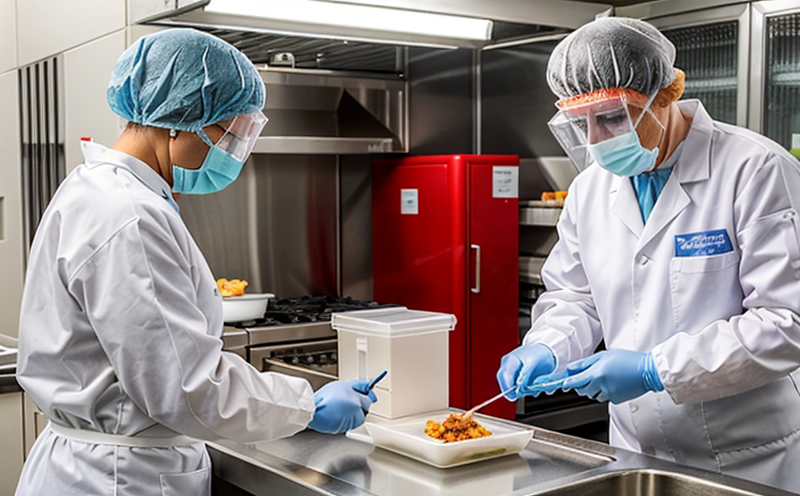ASTM E3250 Standard Test Method for Hepatitis A Virus in Food by RT-PCR
The ASTM E3250 standard test method provides a robust and reliable approach to detecting Hepatitis A virus (HAV) in food products. This method, which is based on reverse transcription polymerase chain reaction (RT-PCR), ensures high sensitivity and specificity for the detection of HAV. The procedure involves several critical steps that are designed to ensure accurate and reproducible results.
The first step in this test protocol is the collection and preparation of the food specimen. Proper sampling is crucial to ensure representativeness, which can significantly impact the outcome. After collection, the sample undergoes homogenization using appropriate buffers to ensure complete disruption of the viral particles. The next stage involves extraction of nucleic acids from the specimen using commercial kits that are compatible with RT-PCR techniques.
The extracted nucleic acid is then subjected to reverse transcription if RNA viruses like HAV are being targeted, followed by amplification via PCR technology. This process leverages specific primers designed for the target gene sequences of HAV. The amplified product can be analyzed using various methods including gel electrophoresis or real-time qPCR, where quantification and confirmation of presence occur.
The accuracy and reliability of this method are further enhanced through strict adherence to standardized protocols outlined in ASTM E3250. This includes precise temperature cycling parameters, optimal concentrations of reagents, and careful handling during the entire procedure to minimize contamination risks. The use of real-time qPCR machines equipped with fluorescence detection capabilities allows for quantification based on cycle threshold (Ct) values.
Results from this test are presented as presence or absence of HAV RNA in the tested food sample along with potential quantitative measures if applicable. Compliance with such standards is essential not only to meet regulatory requirements but also to safeguard public health by ensuring that potentially contaminated products do not reach consumers.
The implementation of ASTM E3250 ensures consistency across laboratories performing this test, thereby facilitating comparability and traceability of results worldwide. It supports the development of effective prevention strategies against HAV outbreaks associated with foodborne illnesses.
Why It Matters
Ensuring the safety and quality of food products is paramount in maintaining public health standards globally. The presence of pathogens like Hepatitis A virus (HAV) in food can pose significant risks to human health, leading to acute liver disease among other complications if not properly managed.
- Food Safety: Detecting HAV early through rigorous testing helps prevent contamination and subsequent spread within the food supply chain.
- Regulatory Compliance: Adherence to international standards such as ASTM E3250 ensures that manufacturers meet stringent regulatory requirements set forth by health authorities.
- Patient Well-being: By identifying and eliminating sources of HAV contamination, this testing method contributes significantly towards protecting vulnerable populations who are more susceptible to severe outcomes from viral infections.
- Economic Impact: Preventing outbreaks not only saves lives but also protects businesses against costly recalls and reputational damage stemming from contaminated products.
In summary, implementing ASTM E3250 for HAV detection is crucial in upholding the highest standards of food safety and quality, ultimately fostering trust between producers and consumers alike.
Competitive Advantage and Market Impact
- Advanced Technology: Utilizing advanced molecular biology techniques like RT-PCR provides a significant edge over traditional methods relying solely on culture-based approaches which may lack sensitivity.
- Precision: The high precision offered by real-time qPCR machines equipped with fluorescence detection ensures accurate quantification of HAV RNA, allowing for more precise risk assessment.
- Rapidity: Quick turnaround times enabled by streamlined laboratory processes enhance operational efficiency and responsiveness to potential threats.
- Broad Acceptance: Compliance with internationally recognized standards like ASTM E3250 enhances credibility among stakeholders including regulatory bodies, customers, and partners.
These advantages contribute to a competitive market position by enabling timely identification of hazards while maintaining robust quality assurance practices. As more industries prioritize safety and compliance, laboratories adhering to such stringent protocols are poised to lead the field in terms of service offerings and client satisfaction.
Use Cases and Application Examples
The ASTM E3250 test method finds application across various sectors including food manufacturing, retail, and healthcare. Herein lie some specific scenarios where this technology plays a pivotal role:
- Manufacturing Facilities: Regular testing of raw materials before processing helps prevent cross-contamination from initial stages.
- Retail Stores: Periodic sampling and analysis at point-of-sale locations ensure that sold products meet safety standards.
- Clinical Trials: Monitoring for HAV in test subjects during vaccine efficacy studies provides valuable data on protective immunity levels achieved.
In addition to these applications, research institutions conducting epidemiological surveys often employ this technique to track trends and identify patterns associated with HAV transmission routes.
The versatility of ASTM E3250 extends beyond mere detection; it serves as an essential tool in formulating preventive measures aimed at reducing incidences of foodborne illnesses caused by viral pathogens like HAV. By integrating this methodology into their routine operations, organizations can contribute significantly towards building safer food systems.





